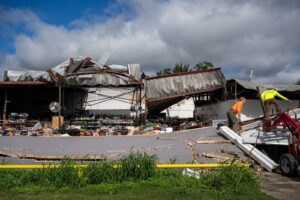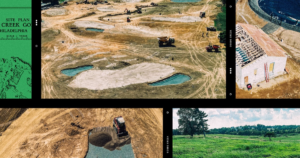A dead Russian satellite broke up into more than 100 pieces of debris in orbit, leaving astronauts on the International Space Station to seek shelter for about an hour and add to the mass of space junk already in orbit, US space agencies said.
There were no immediate details on what caused the disintegration of the Resurs-P1 Russian Earth observation satellite, which Russia declared dead in 2022.
USA Space Command, which was monitoring the debris swarm, said there was no immediate threat to other satellites.
The event took place around 10:00 a.m. mountain time (1600 GMT) on Wednesday, Space Command said. It happened in orbit near the space station, forcing US astronauts aboard to shelter in their spacecraft for about an hour, Nasa’s space station office said.
The Russian space agency Roscosmos, which operated the satellite, did not respond to a request for comment or publicly acknowledge the event on its social media channels.
US Space Command, which has a global network of space tracking radars, said the satellite immediately created “more than 100 pieces of trackable debris”.
By Thursday afternoon, radars from the US space tracking firm LeoLabs had detected at least 180 pieces, the company said.
Large debris-generating events in orbit are rare, but of increasing concern as space becomes crowded with satellite networks essential to everyday life on Earth, from broadband internet and communications to basic navigation services, as well as satellites that are no longer in use .
The satellite’s breakup was at an altitude of about 220 miles (355 km) in low Earth orbit, a popular region where thousands of small to large satellites operate.
“Due to the low orbit of this debris cloud, we estimate it will be weeks to months before the danger is over,” LeoLabs said in a statement to Reuters.
The approximately 25,000 pieces of debris larger than 4 inches (10 cm) in space caused by satellite explosions or collisions have raised concerns about the prospect of a Kessler effect – a phenomenon in which satellite collisions with debris create a cascading field of more dangerous debris can create. increases collision risks exponentially.
In 2021, Russia drew strong criticism from the US and other Western countries when it hit one of its decommissioned satellites in orbit with a ground-based anti-satellite (Asat) missile launched from its Plesetsk rocket site. The explosion, testing a weapons system ahead of Moscow’s 2022 invasion of Ukrainecreated thousands of pieces of orbital debris.
In the roughly 88-minute window of Resurs-P1’s initial breakup, the Plesetsk site was one of many locations on Earth it passed over, but there was no immediate indication of airspace or maritime warnings that Russia had launched a missile to hit the satellite, said Jonathan McDowell, a space tracker and Harvard astronomer.
“I find it hard to believe that they would use such a large satellite as an Asat target,” McDowell said. “But, with the Russians these days, who knows.”
He and other analysts speculated that the breakup was more likely caused by a problem with the satellite, such as residual fuel on board causing an explosion.
What happens to old satellites
Dead satellites either remain in orbit until they plunge into Earth’s atmosphere for a fiery demise years later, or, in commonly preferred—but less common—circumstances, they fly to a “graveyard orbit” of about 22,400 miles (36,000 km) from Earth to lower the risk of colliding with active satellites.
Roscosmos decommissioned Resurs-P1 in 2021 due to onboard equipment faults and announced the decision the following year. Since then, the satellite has appeared to lower its altitude through layers of other active satellites for an eventual atmospheric re-entry.
The six U.S. astronauts currently on the space station were alerted by Nasa mission control in Houston at around 9:00 p.m. ET Wednesday (0100 GMT on Thursday) to perform “safe harbor” procedures, where each crew member leaves the spacecraft in which they arrived have, rush in, in case an emergency exit is required.
NASA astronauts Butch Wilmore and Suni Williams boarded their Starliner spacecraft, the Boeing-built capsule that has been docked since June 6 in its first crewed test mission to the station.
Three of the other American astronauts and a Russian astronaut entered SpaceX’s Crew Dragon capsule, which flew them to the station in March, while the sixth American astronaut joined the two remaining astronauts in their Russian Soyuz capsule, which transported them there in September last year. .
The astronauts came out of their spacecraft about an hour later and resumed their normal work on the station, Nasa said.
The prospect of satellite collisions and space warfare has added urgency to calls from space advocates and legal scholars for countries to establish an international mechanism to manage space traffic, which does not currently exist.




